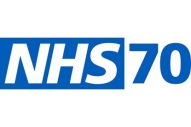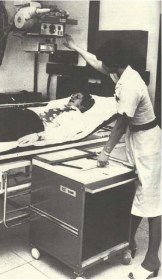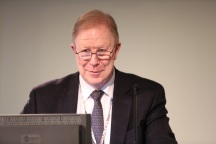
Dr Edwin Aird shares his memories of the revolution he has experienced working in the medical physics department.

While I was an undergraduate at Newcastle University (1962), the 2nd year honours group was invited to visit the Medical Physics Department at Newcastle General Hospital. I was so impressed with the department and the range of things they were doing and the application of physics to medicine that I wrote to Professor Frank Farmer (Head of Department at that time) to ask about working there. He responded with a proposal that I apply for a special research grant that he was hoping for locally and that I write again after my graduation.
The following year I got in touch with Frank Farmer again and was accepted on an MSc grant to study “In-homogeneities in Radiotherapy”; one year in the first instance (on a grant of about £700).

I can’t now remember my first day exactly; not sure what office I had, but I do remember the Professor’s insistence on donning a white coat (provided and laundered by the hospital) when arriving at work, This ‘uniform’ was thought to be a vital sign to patients that physicists were part of the ‘clinical’ team.
I divided my time in that first year between research and clinical work (interestingly, this was part of the philosophy of some of the early physicists, many of whom in the 1930s and 40s had transferred from academic physics, including Frank Farmer); the situation now couldn’t be more different.

Image 1 The gantry mounted linear accelerator at Newcastle General Hospital [ref 2]
The main linear accelerator was manufactured by Mullard (a branch of Philips), which Frank Farmer had installed as the first gantry-mounted 4MV linac (image 2). There were a few stories about the installation of this linac. In particular I remember this: the team had reached the point where they needed to produce X-rays so needed a high atomic number transmission target. Someone found a sovereign, but forgot the amount of heat produced when the high energy electrons hit it. The sovereign promptly melted and fell out of the linac head. (This linac went on to perform 25 years’ service).

Fig 2 Newcastle Simulator (Frank Farmer at Controls) [ref 3]

Fig 3 A Head and Neck Xeroradiograph showing potential. Treatment volume [ref 3]
Treatment planning was done by hand, often mainly using % depth dose, but also with some isodose curves for more complex plans on tracing paper; on to an outline of the patient performed using lead wire and other devices, e.g. callipers. Newcastle was unique in having developed a home-made simulator (using a radiotherapy SXT unit mounted on a gantry (image 2) that allowed an image to be viewed on a Xerox plate immediately without the need for film development (ref 3, see also image 3).
The first computer in the department, which was to revolutionise treatment planning, came to Newcastle in the early 1970s and was called a PDP 8, the ‘Rad8 system’ developed by Bentley and Milan. (image 4 [ref 4]).
Radium tubes and needles were still extensively used at this time for intracavitary and interstitial brachytherapy. I was also required to calculate the dwell times for gynae radium insertions (using ovoids and central vaginal sources with a modified Manchester system for the gynae and radium needles, mainly in back of tongue with radiographs and Paterson Parker tables). Following the calculation of the radium dwell times I would then go up to the ward to discuss the removal times, for each patient, with sister on the ward. Amazing now to think how much radioactivity (up to 105mg – equivalent to approximately 389 MBq-or more) for gynae insertions was handled by several different groups of staff at that time.
In those early years I also learnt the elements of radiation protection and nuclear medicine. Radiation Protection (guided by a ‘Code of Practice’; an excellent document that was used to help write the ‘Guidance Note’ now used under Ionising radiation Legislation) was regionally organised. Very early in my career (there were only two of us to perform the external radiation work: myself and MJ Day), I found myself organising visits within Northumberland, Cumbria and parts of Durham. (See The Regional Centre below). These were more as inspections than to make many measurements (not the very extensive QA that is performed now, although we did use film or image intensification – only recently developed – to look for faults in lead aprons; and we measured exposure levels in and out of beam with the ‘37D’ (Pitman) dosemeter (originally developed by Sidney Osborne as an excellent versatile instrument for exposure measurements ref 5). I learnt a pattern of inspection of barriers, filtration, lead aprons etc. very quickly. [In the early 1970s the NRPB decided to do their own inspections and were surprised to find that, because the HPA had organised things so well there was little need for NRPB to get too heavily involved].
My memories of nuclear medicine: incredibly slow rectilinear scanners, prior to the commercial development of gamma cameras; kidney function (renogram) using two ‘D’-shaped detectors (scintillation) with manual optimisation of their positions connected to count rate meters and chart recorders.
The regional centre
I’m not sure how many hospitals this covered in my early days in Northumberland, Tyneside, Durham and Cumbria. I know when Keith Boddy implemented Frank Farmer’s plan to have a small physics department (where gamma cameras were installed in district general hospitals) there were thirteen hospitals with physics departments in the region. Prior to this – from about my 3rd year at Newcastle – I was delegated to look after the small centre in Carlisle where there were two Marconi 250kV sets, an SXT and some iodine treatment. In the 1950s this had been the job of Jack Fowler who used some of his time to study arc therapy on 250kV (see ref 6).

Edwin Aird (right) receiving the BIR Sylvanus Thompson Award from Andy Beavis
In those early years I also found time to help develop differential X-ray absorptiometry to measure antimony in the local Tyneside Antimony workers’ lungs (organised by the Newcastle University Department of Industrial Health). I was also able to build on this experience to develop my own equipment, using characteristic X-rays, to measure bone mineral in the femur. This clinical work allowed me to meet a new set of clinicians (other than radiotherapists – as Clinical Oncologists were then called – and radiologists) involved with bone loss in patients: kidney specialists, endocrinologists and geriatricians. Commercial equipment has since been developed to perform bone mineral and body composition measurements (GE Lunar, Hologic, and Norland).
References:
- Aird EGA and Farmer FT. The design of a thimble chamber for the Farmer dosemeter. Phys Med Biol 1972 17: 169–174. https://doi.org/10.1088/0031-9155/17/2/001
- Day MJ and Farmer FT. The 4 MeV Linear Accelerator at Newcastle upon Tyne. Br J Radiol 1958; 31: 669–682. https://doi.org/10.1259/0007-1285-31-372-669
- Farmer FT, Fowler JF and Haggith JW. Megavoltage Treatment Planning and the Use of Xeroradiography. Br J Radiol 1963; 36: 426–435. https://doi.org/10.1259/0007-1285-36-426-426
- Bentley RE and Milan J. An interactive digital computer system for radiotherapy treatment planning. Br J Radiol 1971; 44: 826–833. https://doi.org/10.1259/0007-1285-44-527-826
- Osborn SB and Borrows RG. An Ionization Chamber for Diagnostic X-Radiation. Med.Biol1958; 3: 37–43. https://doi.org/10.1088/0031-9155/3/1/305
- Fowler JF and Farmer FT. Measured Dose Distributions in Arc and Rotation Therapy: A Critical Comparison of Moving and Fixed Field Techniques. Br J Radiol 1957; 30: 653–659. https://doi.org/10.1259/0007-1285-30-360-653
About Dr Edwin Aird
Edwin Aird was Head of Physics at Mount Vernon Hospital from 1988-2012 and Head of Radiotherapy Physics at St Bartholomew’s Hospital from 1985-1988. He was Head of Radiotherapy Physics at Newcastle General Hospital from 1980-1985. He is an IPEM Chief Examiner 1994-1997 (Physics Training Scheme), FRCR (RT) Examiner 1989-1993, Radiotherapy Degree (External Examiner (Liverpool University): 1993-1996. He is a IAEA: Qualified Expert: 1999-2005 and an LH Gray Trustee: 1999-2003.
He was awarded the BIR Roentgen Prize in 2005 and delivered the Silvanus Thompson: Award and Eponymous Lecture 2013.


 I started my radiological life in the mid seventies at St George’s Hospital. Part of the rotation programme involved some time at the Atkinson Morley Hospital where I came across the first generation scanner. There was an old dental chair on which a patient laid back with his head in a rubber hat in the scanner porthole. It took 8 slices. Each slice took 5 minutes using an old fashioned tomogram X-ray tube. The image details were processed by a very large computer. The resultant image was printed on a photograph. The image matrix was 80 by 80, an advance since the original 40 by 40. How Jamie Ambrose invented the reports I do not know but his detailed knowledge of brain anatomy was quite outstanding.
I started my radiological life in the mid seventies at St George’s Hospital. Part of the rotation programme involved some time at the Atkinson Morley Hospital where I came across the first generation scanner. There was an old dental chair on which a patient laid back with his head in a rubber hat in the scanner porthole. It took 8 slices. Each slice took 5 minutes using an old fashioned tomogram X-ray tube. The image details were processed by a very large computer. The resultant image was printed on a photograph. The image matrix was 80 by 80, an advance since the original 40 by 40. How Jamie Ambrose invented the reports I do not know but his detailed knowledge of brain anatomy was quite outstanding.







 Today’s NHS is nothing like the one I joined in 1966 and specialised scientist training is much more formalised and incalculably better. No one these days could be appointed in the manner that I had been but Dr B, like most other NHS professionals then and now, was motivated by good intentions and his thoughtfulness over fifty years ago put me on the path to a rich and fulfilling career in medical physics and radiobiology. I discovered later in life that Dr B had told one of his colleagues that he had helped me because he “wanted to give the lad a chance”. What he gave me was a chance that was truly exceptional and this lad has been immensely grateful ever since.
Today’s NHS is nothing like the one I joined in 1966 and specialised scientist training is much more formalised and incalculably better. No one these days could be appointed in the manner that I had been but Dr B, like most other NHS professionals then and now, was motivated by good intentions and his thoughtfulness over fifty years ago put me on the path to a rich and fulfilling career in medical physics and radiobiology. I discovered later in life that Dr B had told one of his colleagues that he had helped me because he “wanted to give the lad a chance”. What he gave me was a chance that was truly exceptional and this lad has been immensely grateful ever since. In 2010 Karen Goldstone was awarded the MBE for her services to healthcare. Here she reflects on the primitive tools used for radiotherapy patient outlines back in the 1970s and remembers the wise advice she was given on her first day as a radiotherapy physicist.
In 2010 Karen Goldstone was awarded the MBE for her services to healthcare. Here she reflects on the primitive tools used for radiotherapy patient outlines back in the 1970s and remembers the wise advice she was given on her first day as a radiotherapy physicist.











